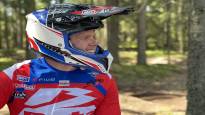Everything is relative.
Steve Holcombe describes Finnish enduro terrains as foreign to him, but when viewed from the side, his ride looks masterful in the first few meters.
The seven-time world champion is preparing for the Finnish World Championship in Heinola on stony and rocky forest paths and gravel. A week before the H-moment, Holcombe’s motor home is parked in the pit of the Numme motocross track in Mäntsälä.
The test day of the 29-year-old British champion can also be watched from the pit stop by Finnish drivers of a younger generation Hermanni Haljala and Samuli Puhakainen.
Twenty years ago, Finnish drivers grabbed the enduro gold in the World Series year after year and dominated their home races. Now the Finnish success has been plowing for several years and as if to underline the situation, the Finnish drivers get tips from the British for their home race.
Steve Holcombe rose to the sharpest peak of the enduro world at the same time as Eero Remes reached the world championships as the last Finnish driver. Currently, there are two Britons in the top three of the main class of the World Championship.
According to Holcombe, even Finns should still look to the future with confidence, because success seems to follow a wave movement. At the time of the greatest Finnish dominance in the 90s and 2000s, even the British only had individual top drivers.
– I think the situation is due to natural development. Every 10-15 years, there are always more good drivers from some area. It starts a cycle of success in the area, which continues for a while until the same thing happens elsewhere. In the 2010s there were more of us British drivers following our lone peak by David Knight excerpts. Then our own competition developed and pushed us forward. Enduro is one of those sports where experience is extremely important. Here, you can still be at the top well into your thirties, if you really want to.
– You have to understand the passage of time in order to gather experience. You shouldn’t lose faith, even if you don’t reach your goal when you originally planned. Of course, the whole thing also requires reliable execution. You should try to avoid unnecessary injuries and the competition equipment and team should be of sufficient quality. For example, in the case of these Finnish drivers, I think it is most important that they continue to do the same work that they have been doing until now, Holcombe encourages.
Hermanni Haljala and Samuli Puhakainen gas up in Mäntsälä’s terrain, closely following the world champion. Sometimes the trio stops by the forest path to discuss driving lines.
– When we’re here in the home country, of course it’s a little easier to try to get him in trouble. When you’re not that much slower than him here, it does give you confidence, Puhakainen describes.
Haljala says he is aiming for a similar cornering style that Holcombe uses. There might also be something to learn from the technical side.
– Yes, such an opportunity is really important to me. Just for the reason that we ride the same bike brand. Then you can get a little more out of, for example, something related to bike adjustments. Of course, it doesn’t go one to one, because he rides a different size bike and is a factory team driver, says Haljala.
Despite the world championships, Holcombe Driving Boots have remained firmly on the ground. At the foot of the fir tree, he patiently answers the Finnish duo’s questions and describes the factors influencing his driving route choices with a surprisingly open feeling.
– I am very happy to help local drivers. I even enjoy teaching. I want to be open and offer answers if they have questions. Why do I act in a certain way or why do I change my driving line somewhere? However, it is different to watch the driving outside of the races. This way they can look more closely in several places and also discuss my solutions. I hope I can still learn something from Eero myself.
With his last sentence, Holcombe suggests that next he is going to train in the rocky terrain of Vantaa with ex-world champion Remse.
A few hours later, Remes and Holcombe were already thinking about driving route options by the side of a suddenly steep cliff. However, the Finnish champion is not able to offer his own style example after knocking himself a few days earlier in the national enduro competition. Remes follows Holcombe’s training in civilian clothes, sometimes riding his electric moped.
Then Holcombe revs up his bike and clears the rock with two low jumps. On the second attempt, he changes his driving line and crosses the kink with one jump.
– Which line do you think is better? Remes asks?
– Yes, the jumping line is better, just as you thought, Holcombe answers.
According to Remse, in practice he only has the role of clocking the lap times.
– Steve has it under control from his own back. Yes, the world champions dominate all driving conditions.
Before Holcombe disappears into the forest for another training round, we still need to find out if the origins of “Pukki Party” could be a familiar concept to the British enduro champion.
– Have you heard Teemu from Puki?
– I don’t. Who is she?
– He has represented Norwich.
– Aha! I don’t really follow football myself, world champion Holcombe says with a big smile.
